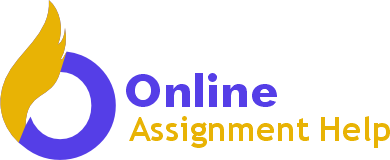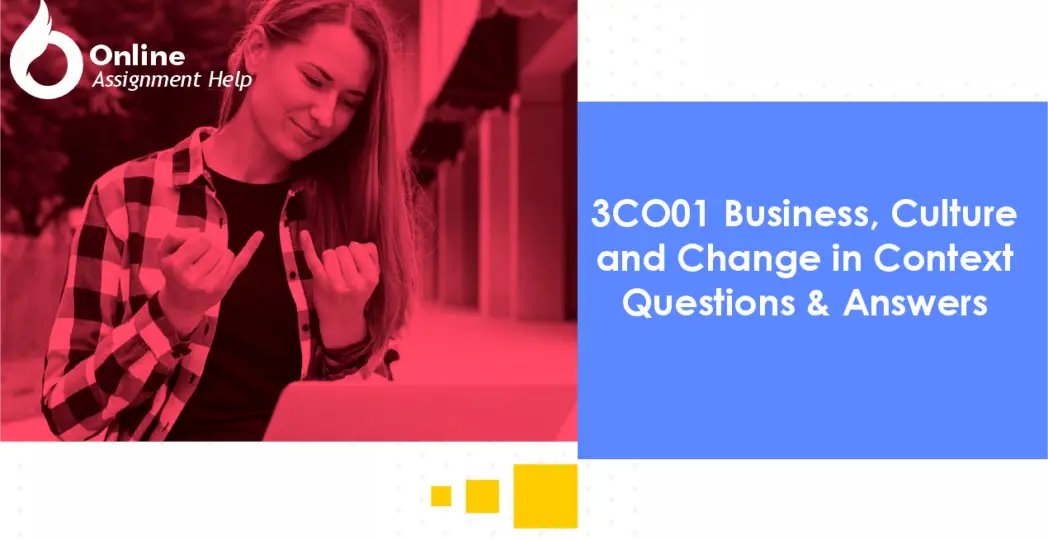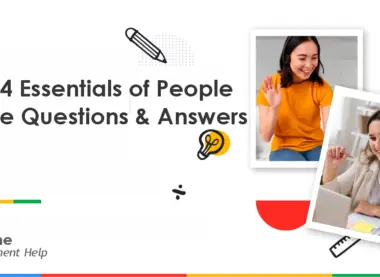Table of Contents
3CO01 Business, Culture and Change in Context Questions
To complete the task, you should provide a written response to each of the nine questions below. You should relate your answers to your own organisation or an organisation with which you are familiar, ideally one that you have worked for. The same organisation should be used for all nine answers.
To be an effective people practitioner it is important to understand the goals of the business, the products, or services the organisation is selling or providing, the main customers of the organisation and how external factors, including technology impact the organisation’s markets and
working methods.
- Examine two key external influences impacting or likely to impact the activities of the organisation that you work for (or an organisation with which you are familiar) (AC 1.1)
- Discuss the main business goal of the organisation that you work for (or an organisation with which you are familiar) and why it is important for that organisation to plan how they will achieve the goal. (AC 1.2)
- Discuss the products and/or services of the organisation that you work for (or an organisation with which you are familiar) and discuss the organisation’s main customers. (AC 1.3)
Technology has transformed workplaces and the people profession. - Review how file sharing technology and video conferencing can be used to improve working
practices and collaboration within the people profession in your organisation (or an
organisation with which you are familiar). (AC 1.4)
In 2023, a CIPD podcast asked the following question, ‘Has working remotely killed organisational culture?’ This topic is of interest in many organisations but before considering the impact of remote working on culture, it is important to understand what it meant by the term organisational culture. - Define organisational culture and explain why it is important to foster an appropriate and effective workplace culture in your organisation (or an organisation with which you are familiar). (AC 2.1)
- Explain how culture is part of a whole system and explain how people professionals’ work and actions could impact elsewhere in your organisation (or an organisation with which you are familiar). (AC 2.2)
According to the CIPD’s Change Management factsheet, one driver of organisational change is
economic downturn and challenging trading conditions. - Explain why it is important that organisational change driven by economic downturn and challenging trading conditions is planned, and effectively managed in your organisation (or an organisation with which you are familiar). (AC 3.1)
- Explain the importance and role that could be played by people professionals in your
organisation (or an organisation with which you are familiar) within change driven by economic
downturn. (AC 3.2) - Discuss how organisational change, driven by economic downturn, could impact people in your
organisation (or an organisation with which you are familiar) in different ways. (AC 3.3)
3CO01 Assignment Answers
AC 1.1
Technological Advancements
One significant external factor impacting Deliveroo UK is technological advancement. With the rise in the usage of mobile apps, artificial intelligence, and data analytics, the food delivery business has taken another turn (Shaeeali et al., 2020). Deliveroo has used this to its advantage by creating an effective yet easy-to-use app that not only enhances the customers’ experience but also makes delivering food relatively easier. However, as technologies such as autonomous delivery drones or robots develop further, and predictive analytics continues to evolve, this may be quite a different story for how Deliveroo conducts business (Puriwat and Tripopsakul, 2020). Competitors in the form of Uber Eats and Just Eat also invest heavily in technology, which places Deliveroo continuously under pressure to innovate and keep up.
For example, Uber Eats has introduced drone deliveries in some locations, which could become a competitive advantage if Deliveroo does not keep pace (Bellan, 2022). In addition, as customers increasingly expect seamless digital experiences, Deliveroo will have to invest in reliable IT infrastructure and cybersecurity measures that protect sensitive customer data against a breach, something of great importance considering the increase in cyberattacks in the industry.
Regulatory Environment
Another critical external factor impacting Deliveroo is the changing regulatory environment related to labor laws. The arguments about the employment status of gig economy workers have continued to heat up in the UK, and there are calls at an increasing rate for businesses such as Deliveroo to provide their riders with additional benefits and job security (Tassinari and Maccarrone, 2020). Recent rulings, such as those regarding the classification of Uber drivers, may broaden the heavy restrictions to encompass the whole gig economy. This could increase operating costs for Deliveroo and force changes to their business model to accommodate the new legal framework.
Competitors who adapt swiftly to these legal changes may attract more workers, thus impacting Deliveroo’s ability to retain its flexible workforce.
AC 1.2
Main Business Goal of Deliveroo UK
Deliveroo’s primary business objective is to be the leading food delivery platform in the UK market by offering its customers fast, reliable, and diverse food alternatives while continuing to have strong restaurant partnerships. The vision of Deliveroo is to make high-quality food available anytime and anywhere using its platform to connect customers, restaurants, and riders efficiently. This objective is very important because revenue growth occurs due to the increasing number of consumers, which also results in the loyalty of restaurants due to the provision of a consistent delivery service (Deliveroo, 2018).
Planning to achieve this goal is crucial for Deliveroo to remain competitive in such a saturated market. With competitors like Uber Eats and Just Eat, Deliveroo has to make sure it invests correctly in technology, expands restaurant partners, and enhances the experience for riders at every instance. For example, “Editions” kitchens introduced by Deliveroo are kitchens that operate only as a delivery service, enabling the firm to offer unique food options in areas with high demand. Proper planning allows Deliveroo to anticipate market changes, allocate resources efficiently, and stay agile in response to external factors like economic downturns or regulatory changes (Deliveroo Editions, 2021).
Clear business goals and mapping out how to achieve them are some of the ways through which Deliveroo ensures adaptability to various challenges while keeping customer satisfaction at the heart of its business.
AC 1.3
Deliveroo’s Products and Services
Deliveroo UK provides an online food delivery service that connects customers with local restaurants, allowing them to order food through a mobile app or website. Deliveroo has an array of cuisines to meet customers’ diverse tastes, from fast food to fine dining. Along with restaurant food, it has created its own delivery-only kitchens, called Deliveroo Editions, in which restaurants do not need a physical location but can increase their reach. That enables the company to develop its services in ways that exclusive restaurant brands are brought to areas that were under-served. Deliveroo also offers grocery delivery services in collaboration with retailers such as Co-op and Waitrose; through those, the customer is able to order groceries alongside food deliveries.
Main Customers
Our company targets tech-savvy urban dwellers searching for convenience and variety in their food options. Primarily, the main customers are millennials and Generation Z, for whom speed, quality, and ease of access are not just essential but pivotal (Deliveroo, 2018). Deliveroo also appeals to busy working professionals and families seeking quick fixes for meals without compromising on quality. Another key customer group is restaurant partners, who depend on Deliveroo to augment their sales and customer volume. Deliveroo’s growing grocery delivery service also attracts customers who prefer online shopping for daily essentials.
AC 1.4
Improving Collaboration with File-Sharing Technology
Tools for collaboration, such as Google Drive and OneDrive, in Deliveroo UK can potentially revolutionize collaboration within the people profession (Castro-Arquinigo et al., 2023). It allows the human resources teams to securely store, organize, and share documents in real-time from any location. For instance, an HR professional can instantly share performance reviews, onboarding documents, or training materials with other departments to facilitate seamless access to information that is not only important but crucial as well. This prevents delays in work processes caused by the use of manual document sharing and ensures that team members are always working with the latest file versions. In addition, the bases for file sharing enhance security through controlled access and permission, protecting sensitive employee information.
Enhancing Communication through Video Conferencing
Video conferencing tools, like Zoom and Microsoft Teams, can further transform collaboration within Deliveroo’s HR teams. These platforms enable virtual meetings, interviews, and training sessions, leading to flexible communication across geographically dispersed teams (Simon, 2021). For example, HR professionals will be able to interview candidates at different locations without necessarily having to meet them physically, hence saving time and resources. Internal collaboration also improves, whereby teams can hold virtual meetings, discuss projects in detail, share their views, and agree on decisions without necessarily having all the participants present at the conference. This proportionately makes it valuable for the remote working model at Deliveroo, where effective communication is of great essence in sustaining productivity and engagement.
Deliveroo’s HR teams can enhance collaboration by integrating file-sharing and video conferencing technology, enabling more efficient and flexible working practices.
AC 2.1
Defining Organisational Culture
Organizational culture is the shared values, beliefs, behaviors, and ways that describe how employees relate to each other and conduct themselves within the organization (Lubis and Hanum, 2020). It involves those unwritten norms and expectations that drive daily work life-from the way communications are purposed to decision-making processes. It’s essentially the “personality” of an organization that guides how work gets done and how employees interact with each other. According to Kaul (2019), the organizational culture consists of three layers: the level of the artefacts, or the visible structure and process; the level of the espoused values, or the strategies and goals; and the level of the basic underlying assumptions, or the beliefs deeply embedded.
Importance of Fostering Workplace Culture
It becomes very critical, therefore, for Deliveroo UK to facilitate an appropriate and effective organizational culture for a number of reasons. First, good culture fuels employee engagement and retention by creating a connection with the employees over a shared sense of belonging and purpose (Chakraborty and Ganguly, 2019). A positive culture allows riders, restaurant partners, and corporate teams to work in harmony, which is very important in Deliveroo’s fast-moving environment. Additionally, the culture that is in tandem with the company’s strategic objectives ensures that the will of employees to help the business thrive is present. For example, Deliveroo’s innovative and customer-focused approach motivates its employees to find ways to continuously improve service delivery to satisfy customers.
A healthy workplace culture also improves brand reputation, attracts top talent, and fosters trust among stakeholders, ultimately supporting long-term growth.
AC 2.2
Organisational Culture as a Whole System
Organisational culture is an integral part of the entire system within a company, influencing every aspect of how it functions. It forms an essential constituent at Deliveroo UK, connecting various parts, including leadership and employee behavior, operational practices, and all relationships. When one part of the system is altered, culture changes to adapt to accommodate the new way employees conduct their business and interact with each other. For instance, the transition to a virtual, flexible work environment involves changes in communication practices, collaboration, and trust-building across teams (Oh and Han, 2020).
Impact of People Professionals’ Actions
People professionals help shape organisational culture through hiring, training, and performance management practices (Armstrong and Taylor, 2023). At Deliveroo, this carries significant weight in other areas of the business. For example, if HR drove a culture of inclusivity through implementing diversity and inclusion initiatives, it would affect hiring practices, decision-making, and team dynamics across the organization. Offering flexible working conditions, which demonstrates a commitment to employees’ well-being, may have the effect of increasing their levels of engagement and productivity while creating the need to adjust how performance is measured and supported.
Furthermore, the focus of HR on continuous learning and development helps the staff to be prepared with the skills necessary for responding to challenges in business through innovation and operational efficiency. The bottom line is that the contribution of people professionals reverberates throughout the organisation to strengthen its culture and influence overall performance.
AC 3.1
Importance of Planned Organisational Change in Economic Downturns
Economic downturns and challenging trading conditions can significantly impact the operations of companies like Deliveroo UK. At these difficult times, depressed consumer spending, increased operational costs, and extreme competition are some of the challenges an organization has to endure. In coping effectively with these challenges, planning and managing organizational change becomes crucial.
Planning will, therefore, make it possible to locate the most important areas needing change, like cost reduction, process improvement, or restructuring (Rosenbaum et al., 2018). This may mean streamlining Deliveroo’s delivery operations or renegotiating contracts with restaurant partners to maintain profitability. A clear plan ensures that resources are utilized efficiently and that the organization remains focused on its strategic priorities.
Meanwhile, effective change management is also crucial to ensure staff morale during times of uncertainty, minimizing disruption. A clearly communicated strategy for change ensures openness; employees can track the decisions taken and the expected results. For example, if Deliveroo delivers its promises regarding cost-cutting measures, such as cutting working hours or letting some employees go, sensitivity and clarity in handling the process may retain trust and lower resistance.
Effective change management also ensures business continuity. For this reason, Deliveroo can compete competitively in worsening trading conditions. By shaping and introducing planned change, the company can move forward and protect core operations while allowing long-term growth.
AC 3.2
Role of People Professionals in Change Management During Economic Downturn
In Deliveroo UK’s economic downturn, people professionals are of utmost significance in organizational change management. From the HR perspective, they are supposed to manage workforce-related adjustments, ensuring that they are relevant to the company’s strategic objectives. In this respect, their role is highly instrumental in maintaining morale, productivity, and legal compliance in times of utmost distress.
Firstly, people professionals are instrumental in designing and executing workforce planning strategies. This may include decisions around layoffs, redeployments, or salary adjustments to help the organisation manage costs. This is done to ensure that Deliveroo will be able to continue with its business in an agile way while protecting its key talents.
People professionals also act as communicators to enable transparency and building trust when change occurs. They craft clear messaging related to the reasoning for the change (for instance, cost-saving measures) and support managers in communicating these efficiently to other employees. This reduces uncertainty and fear for employees, allowing them a smoother transition from one phase to another (Armstrong and Taylor, 2023).
Lastly, HR is instrumental in caring for and attentioning employees during times of turbulence through post-mental health support, flexible working, and ongoing professional development. These initiatives may reduce the impact of economic challenges on employee engagement and productivity, which may help Deliveroo retain motivated and resilient workforces.
AC 3.3
Impact of Organisational Change Due to Economic Downturn on People
Organisational change driven by economic downturns may affect Deliveroo UK employees differently, depending on their roles in the organization, job security, and ability to adapt to change. These impacts would more often be characterised by the nature and extent of changes, one example being layoffs, another one being pay cuts, or restructuring.
The primary concern for frontline workers, such as delivery riders, is job security. Lower customer demand translates to fewer shifts and, by that same virtue, less income. Riders may be put under ever-increasing pressure to deliver quicker, thus affecting morale and work-life balance. In some cases, new performance metrics associated with changes in the operational process further raise stress levels regarding job security in light of the financial downturn.
With economic downturns, corporate employees, especially at the middle management level, usually face added workload and responsibility due to team shrinkage caused by layoffs or restructuring (Rosenbaum et al., 2018). This acts as a catalyst for burnout or job satisfaction diminishment because employees have to assume and handle more responsibilities with minimal resources.
Senior management may face more significant burdens from decision-making, as the bottom line of profitability must be balanced with managing people’s livelihoods. Such decisions can touch their sense of well-being, and ethical dilemmas may arise.
Therefore, the overall impact of the economic decline will be increased stress, uncertainty, and job insecurity at all organizational levels, which will require a particularly effective means of communication and support.
References
Armstrong, M. and Taylor, S., 2023. Armstrong’s handbook of human resource management practice: A guide to the theory and practice of people management. Kogan Page Publishers.
Bellan, R. (2022) ‘Uber Eats pilots autonomous delivery with Serve Robotics, Motional,’ TechCrunch, 16 May. https://techcrunch.com/2022/05/15/uber-eats-pilots-autonomous-delivery-with-serve-robotics-motional/.
Castro-Arquinigo, M.F., Janjachi-Nieto, N.S., Peña-Flores, E.J., Alvaro-Enrriquez, J.A., Huamanchahua, D., Escobar-Baquerizo, S. and Valcarcel-Castillo, H., 2023, November. Collaborative Tools for Project Management: A Technological Review. In 2023 IEEE Colombian Caribbean Conference (C3) (pp. 1-6). IEEE.
Chakraborty, T. and Ganguly, M., 2019. Crafting engaged employees through positive work environment: Perspectives of employee engagement. In Management techniques for employee engagement in contemporary organizations (pp. 180-198). IGI Global.
Deliveroo (2018). https://deliveroo.co.uk/about-us.
Deliveroo Editions | Virtual Restaurant Service | Deliveroo (2021). https://restaurants.deliveroo.com/en-gb/editions.
Kaul, A., 2019. Culture vs strategy: which to precede, which to align?. Journal of Strategy and Management, 12(1), pp.116-136.
Lubis, F.R. and Hanum, F., 2020, December. Organizational culture. In 2nd Yogyakarta International Conference on Educational Management/Administration and Pedagogy (YICEMAP 2019) (pp. 88-91). Atlantis Press.
Oh, S.Y. and Han, H.S., 2020. Facilitating organisational learning activities: Types of organisational culture and their influence on organisational learning and performance. Knowledge Management Research & Practice, 18(1), pp.1-15.
Puriwat, W. and Tripopsakul, S., 2021. Understanding food delivery mobile application technology adoption: A utaut model integrating perceived fear of covid-19. Emerging Science Journal, 5, pp.94-104.
Rosenbaum, D., More, E. and Steane, P., 2018. Planned organisational change management: Forward to the past? An exploratory literature review. Journal of Organizational Change Management, 31(2), pp.286-303.
Shaeeali, N.S., Mohamed, A. and Mutalib, S., 2020. Customer reviews analytics on food delivery services in social media: A review. IAES Int. J. Artif. Intell, 9(4), p.691.
Simon, P., 2021. Reimagining collaboration: Slack, Microsoft Teams, Zoom, and the post-COVID world of work. Racket Publishing.
Tassinari, A. and Maccarrone, V., 2020. Riders on the storm: Workplace solidarity among gig economy couriers in Italy and the UK. Work, employment and society, 34(1), pp.35-54.





